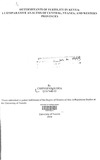| dc.description.abstract | Kenya is one of the countries in sub-Saharan Africa that is at last experiencing a decline in fertility. This decline has been attributed to so many factors such as increase in contraceptive use, rapid social change - especially increased formal education for women, greater government legitimization of family planning, grater bureaucratic efficiency especially in the distribution of contraceptives and so on.
The decline in fertility affected geographical and social categories of the population in a similar way, however, not to the same extent. The objective of this study was therefore to find out factors that have contributed to the differentials ion fertility between Nyanza, Western, and Central provinces of Kenya.
The data that was used was the Kenya Demographic and Health Survey that was carried out in 1993.
Various statistical techniques were used to test the hypotheses, these were the OLS (ordinary least squares) regression method, logistic regression model, and chi-square test. The objectives of the study was carried out based on the Easterlin and Crimmins theoretical framework which is one of the economic theories based on supply - demand aspects.
The study found out that the differentials in fertility between Central province and Nyanza and Western provinces could have been due to the fact that woman are desiring smaller families, they are spending more years in school and are more exposed to mass media.
Hence, they are more likely to be exposed to family planning information, modem ideas that can compete with traditional norms of marriage and child bearing. The low number of children dead per woman could have also been a contributory factor hence they are able to achieve their desired family size without having to give birth to many children. The low marital duration, another indicator of modernization, could have also been a contributory factor as well as the low physic cost of contraception.
The study found out that marital duration greatly influence fertility as it leads to a wider period of exposure to the risk of conception Education was also found to be closely associated with the various aspects of fertility such as desired family size, contraception, and potential supply of surviving children High proportion of child loss greatly influenced the variation in fertility in the three provinces probably because of the replacement effect and insurance effect of child loss. | en_US |



